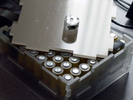











We present Bonfire, a self-contained mobile computing system that uses two laptop-mounted laser micro-projectors to project an interactive display space to either side of a laptop keyboard. Coupled with each micro-projector is a camera to enable hand gesture tracking, object recognition, and information transfer within the projected space. Thus, Bonfire is neither a pure laptop system nor a pure tabletop system, but an integration of the two into one new nomadic computing platform. This integration (1) enables observing the periphery and responding appropriately, e.g., to the casual placement of objects within its field of view, (2) enables integration between physical and digital objects via computer vision, (3) provides a horizontal surface in tandem with the usual vertical laptop display, allowing direct pointing and gestures, and (4) enlarges the input/output space to enrich existing applications. We describe Bonfire's architecture, and offer scenarios that highlight Bonfire's advantages. We also include lessons learned and insights for further development and use.



ThinSight is a novel optical sensing system, fully integrated into a thin form factor display, capable of detecting multi-ple fingers placed on or near the display surface. We describe this new hardware in detail, and demonstrate how it can be embedded behind a regular LCD, allowing sensing without degradation of display capability. With our approach, fingertips and hands are clearly identifiable through the display. The approach of optical sensing also opens up the exciting possibility for detecting other physical objects and visual markers through the display, and some initial experiments are described. We also discuss other novel capabilities of our system: interaction at a distance using IR pointing devices, and IR-based communication with other electronic devices through the display. A major advantage of ThinSight over existing camera and projector based optical systems is its compact, thin form-factor making such systems even more deployable. We therefore envisage using ThinSight to capture rich sensor data through the display which can be processed using computer vision techniques to enable both multi-touch and tangible interaction.
